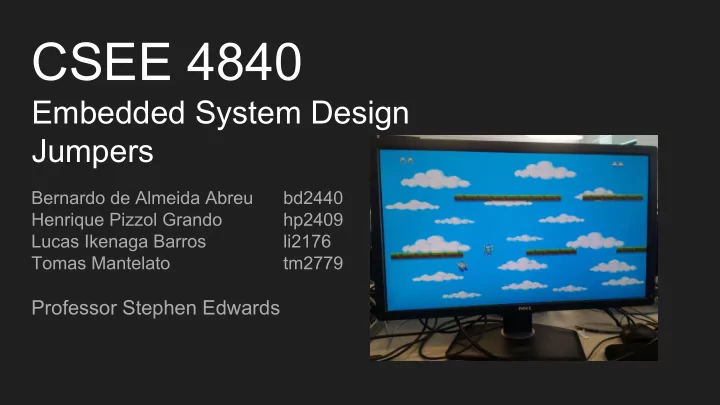

CSEE 4840 Embedded System Design Jumpers Bernardo de Almeida Abreu bd2440 Henrique Pizzol Grando hp2409 Lucas Ikenaga Barros li2176 Tomas Mantelato tm2779 Professor Stephen Edwards
Overview and Objectives ● The objective of this project was to develop a game controlled by an accelerometer, in a FPGA board. ● The game is composed by two players that need to jump over platforms in order to stay alive. ● If a player reaches the bottom of the screen he loses the game ● The accelerometer will define the horizontal velocity in which the player moves around. ● The number of lives that a character has is pictured by the number of icons representing himself at the top of the screen
Design Diagram
Hardware Peripherals Accelerometer: ● ADXL335 (3 axis accelerometer) ● Only one of the axis controls the horizontal displacement of the character ● Connected to the Teensy 2.0 through analog pins
Hardware Peripherals Teensy 2.0 (ATmega32u4 USB development board) ● Reads data from accelerometer and sends to the FPGA via USB ● Arduino compatible. Why we used it? The teensy is a plug and play device that shows up as keyboard when connected. We could use the driver from Lab 2.
Hardware Sprites ● The sprites created for this game are divided in icon sprites and the gameplay sprites ● The icon sprites have a size of 16x16 whereas all the other sprites have a size of 32x32 ● There is a color palette of 19 colors ● The sprites can be mirrored through the hardware
Hardware Background ● The background has a size of 320x240 and the hardware increases its size by a factor of 2 ● The color palette of the background has 4 colors
Hardware The instructions were used in the following ways 1 0001 010 001 0 0001010000 0001010000 Layer Shape Id Count Invert y position x position 0 001 0010 010 0 0001010010 0010110000 Layer Unused Id Count Invert y position x position 00001010 00110011 01010110 0 0 010 011 Red Green Blue unused choice life 2 life 1
Software The software can be categorized in three different parts: 1. Main game logic ● Implemented by a user C program ● Randomly generated grounds ● Collision Handling ● Gravity Simulation ● Input received from user through an accelerometer to move the characters
Software 2. Communication with our hardware ● ioctl calls ● send sprites and their position 3. Communication with peripherals ● Uses USB library ● Accelerometer treated as keyboard ● Treats information received from peripheral
Recommend
More recommend